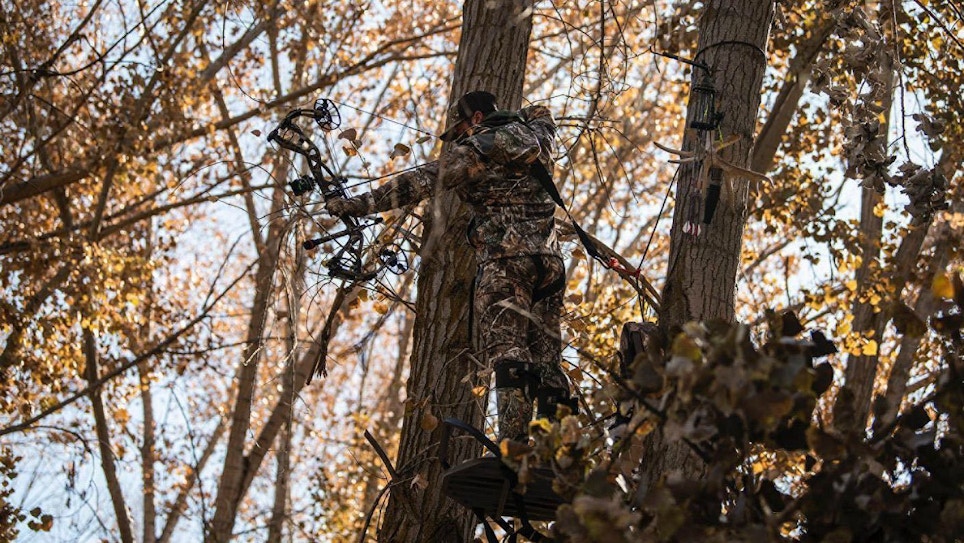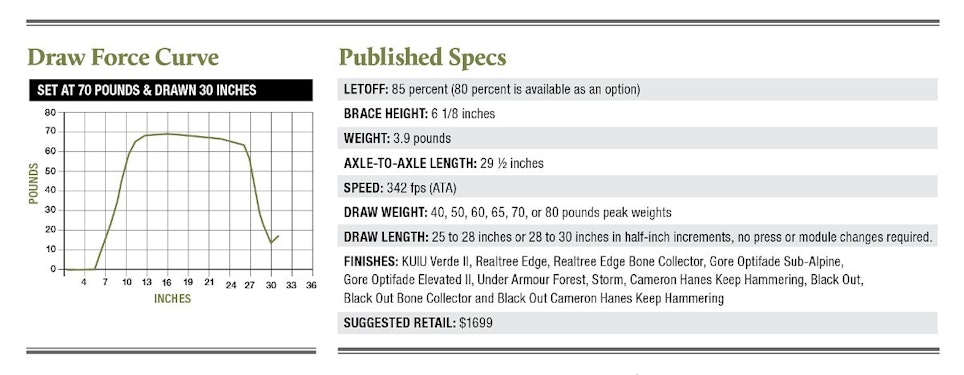Hoyt produces excellent aluminum riser bows, but when most bowhunters think of carbon riser bows, chances are they’re thinking of a Hoyt. Hoyt’s uniquely bridged, single-tube carbon risers make for a rock-solid shooting platform with a unique and curvaceously un-machine-like appearance, and the new Alpha Series Carbon RX4 carries on that tradition. The RX4 boasts several significant and brand-spanking-new design features, starting with the ZTR cam system.
The cams themselves differ from previous Hoyt cams in part by maintaining peak weight a little farther into the draw cycle, which no doubt contributes to this bow’s higher speed rating. The modular adjustable draw lengths cover a slightly narrower range, from 25 to 28 inches on the #2 cam, 28 to 30 inches on the #3 cam, and this should offer a slight increase in efficiency as well. Finally, the draw stops are different this year. They’re integrated into the draw length module so that they don’t need to be moved separately, and they have larger, flat faces, as opposed to the typical round peg style of draw stop. There is a stop on the top cam, but on the bottom cam there are two stops, one on either side of the cam. The combination of the larger, flat surfaces and twin stops on the bottom cam make for a firmer back wall — not quite as hard as a limb stop, but firmer than other cable stops.
Retained from last year’s system is the yoke splitting the cable to a take-up on either side of the bottom cam, to reduce cam lean. At the same time, this makes the bottom limbs necessarily wider (i.e. farther apart), which makes the bottom limb pocket bigger and heavier than the top one. It’s a unique design that improves balance by obviating the top-heavy quality of almost all compound bows.
The new dovetail rest mount is superior to a Berger-hole mount. When used with a Hoyt Ultrarest from QAD, it makes for a rest that is virtually unmovable — a feature I could have used on a recent Texas hunt when I somehow knocked my rest out of kilter hauling it into a treestand.
This year’s riser is bridged slightly differently from last year’s RX3, and what’s more significant, is it’s shorter. At 29 ½ inches, the Carbon RX4 is Hoyt’s shortest bow yet, at least in terms of a premium compound hunting bow. That probably accounts for the slightly lower weight of 3.9 pounds. The adjustable grip is back, and the roller guards and string stop remain unchanged as well, along with the Shock Pods and the offset front and rear stabilizer mounts.
The test bow was finished in Gore Optifade Elevated II, and the fit and finish were what you’d expect from a bow in this price range, which is to say flawless and durable. I referenced earlier the unique appearance of Hoyt’s carbon bow. It’s something you like or don’t like; I happen to like it, but this bow in this finish struck me as among Hoyt’s sharper-looking offerings in recent years.
Shooting the Hoyt Carbon RX4 Alpha
The test bow out of the box was at 72 pounds, so this was adjusted to the standard IBO 70 pounds. Limb bolts were snug but turned without slipping or chattering and without resorting to a vice. I experimented with changing the draw length, and this was more easily accomplished than is normally the case with other bows, including earlier Hoyt models. All standard accessories were easily accommodated, including our non-Hoyt QAD Ultra Rest. The bow was paper tuned in a matter of minutes.
Apart from the expected lightweight, most shooters will probably notice that the RX4 is well balanced for a compound bow, and that balance contributes to a steady hold at full draw, exceptionally so for a bow this compact. Grip preferences are unavoidably subjective, but this one was sufficiently comfortable that I felt no need to adjust it. Some bows feel fast, and the RX4 struck me as one of those. At the shot, it pops forward slightly into a loose grip, but with no vibration, and that was without a stabilizer. It’s quiet, as indicated by the decibel meter. I mentioned earlier that the bow remains close to peak weight a little later into the draw cycle. That is more evident in the draw force curve than in the shooting of the bow. The perception is one of smoothness, with no bumps or thumps. The valley is comfortably deep, and as previously mentioned, the back wall is solid.
Compactness is often referenced regarding treestand and ground blind use, but it’s on spot-and-stalk hunts that I most appreciate a compact bow. Whether I’m carrying it on my backpack as I climb a steep grade or holding it in front of me as I crawl into position for a shot, a light, compact bow is most appreciated. And while compact bows can create problems for some shooters at longer draw lengths, the way the string comes off the tops of the oversized ZTR cams to some degree negates that potential problem.
The price tag alone tells you this bow is not for all bowhunters. Every hunter wants a bow that is tough, reliable, accurate, and forgiving; and, many hunters also prefer compact and lightweight. But if, in addition to all those qualities, you need to love your bow, the Carbon RX4 is a great choice.
Sidebar: How We Test
- Each bow is carefully inspected out of the box for fit and finish and for any visible defects in workmanship. Axle-to-axle length, brace height, mass weight and draw length are measured and compared with stated specs. Minor discrepancies in draw length are corrected or noted.
- A QAD UltraRest is installed, and each bow is equipped with a TruGlo sight, a TruGlo stabilizer, a G5 1/4-inch Metapeep and a D-loop. Test arrows are Carbon Express Maxima Red arrows at weights of 385 and 440 grains, fletched with Bohning Blazer vanes and fitted with QAD Tune-A-Nocks. Peak draw weight is established, and draw force curves, along with letoff, are determined using an Easton Bow Force Mapping System.
- Using a Spot-Hogg Hooter Shooter bow-shooting machine and a ProChrono chronograph, arrow speed and kinetic energy are measured at point of launch and at 20 yards.
- Sound is measured with an NM102 Sound Level Meter with mic positioned 3 feet in front of the bow and 18 inches under the arrow flight path.
- All bows are pressed on a Buckeye Archery Solutions Bow-A-Constrictor press.









